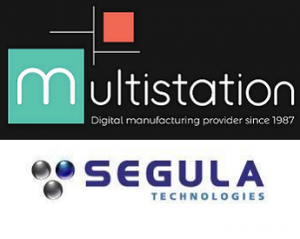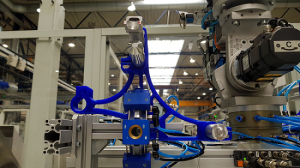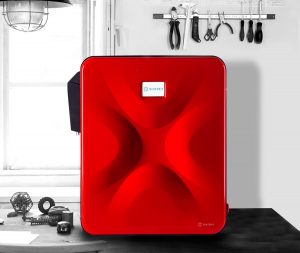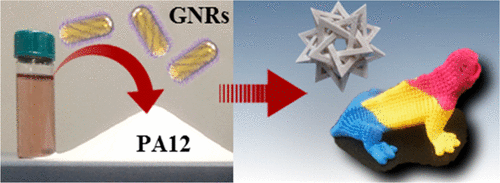AMPHIBIO: A Gill Garment For Our Aquatic Future #WearableWednesday
Biomimicry designer Jun Kamei has created the Amphibio in response to rising sea levels. The gill-like device claims to capture oxygen and disperse carbon dioxide from surrounding water.
Via Junkamei.com:
By 2100, a temperature rise of 3.2℃ is predicted to happen, causing a sea level rise affecting more that 30% of the global population and submerging the megacities situated in the coastal areas.
AMPHIBIO is a 3D printed amphibious garment which function as a gill. Designed for a future where humankind lives in very close proximity with water, it provides daily comfort to people who spend as much time in the water as on the land.
AMPHIBIO is made out of a special porous hydrophobic material which supports underwater breathing by replenishing oxygen from the surrounding water and dissipating carbon dioxide which accumulate in the system, inspired from the gill of water diving insects. The material can be shaped in complex form using 3D printing. Patent pending.
 Every Wednesday is Wearable Wednesday here at Adafruit! We’re bringing you the blinkiest, most fashionable, innovative, and useful wearables from around the web and in our own original projects featuring our wearable Arduino-compatible platform, FLORA. Be sure to post up your wearables projects in the forums or send us a link and you might be featured here on Wearable Wednesday!
Every Wednesday is Wearable Wednesday here at Adafruit! We’re bringing you the blinkiest, most fashionable, innovative, and useful wearables from around the web and in our own original projects featuring our wearable Arduino-compatible platform, FLORA. Be sure to post up your wearables projects in the forums or send us a link and you might be featured here on Wearable Wednesday!
Breakthrough Made in 3D Printing White and Brightly Colored Objects with Polymer Powder
Selective laser sintering is becoming an increasingly popular method of 3D printing, due to its numerous advantages: it produces parts with high strength and stiffness, is capable of creating extremely complex geometries, and requires no supports and therefore very little post-processing. It’s also becoming more accessible, thanks to the development of desktop SLS 3D printers such as the Sinterit Lisa. The use of photothermal sensitizers to facilitate the sintering of polymer powders is becoming more common, but there’s one drawback: conventional carbon-based synthesizers can only produce gray or black parts.
3D printed parts can be dyed or painted, but dark gray or black objects are much harder to color than white or lighter-colored ones. Therefore, a group of researchers decided to find out of photothermal sensitizers could be developed that would produce white or colored parts. They presented their research in a paper entitled “White and Brightly Colored 3D Printing Based on Resonant Photothermal Sensitizers,” which you can access here.
“The use of photothermal sensitizers to facilitate the sintering of polymer powders is rapidly becoming a pivotal additive manufacturing technology, impacting multiple sectors of industry,” the researchers state. “However, conventional carbon-based sensitizers can only produce black or gray objects. To create white or colorful prints with this method, visibly transparent equivalents are needed. Here, we address this problem by designing resonant photothermal sensitizers made of plasmonic nanoparticles that strongly absorb in the near-infrared, while only minimally interacting with visible light.”
To create stable colorful nanocomposite powders, gold nanorods were coated with silica before being mixed with polyamide powders. At resonance, according to the researchers, the composites showed greatly improved light-to-heat conversion compared with equivalent composites using the industry standard carbon black as a synthesizer. The composites could also be sintered using low-power light sources. The resulting powders and 3D prints made from the powders appeared bright white and could produce colorful objects when mixed with dyes.
“Our results open a new route to utilize plasmonic nanoparticles to produce colorful and functional 3D-printed objects,” the researchers explain.
The recently published study is encouraging for those who want to pursue applications in which color is a necessary element. Even the best dyes have trouble turning black objects into brightly colored ones, and it’s especially difficult to get white objects from black or gray. There’s a reason that white is such a popular color choice for FDM filament; it can easily be dyed or painted to obtain just about any color. Thanks to this research, people working with photothermal sensitizers for laser sintering can have that option as well.
When discussing the properties of 3D printed objects, color may not seem like the most important element, but it does carry a lot of importance in many applications – artistic ones, for example, or in manufacturing environments where different parts are identified by color. When black and gray are the only options, applications are limited. With bright white or color as options, however, new possibilities are opened up.
Authors of the paper include Alexander W. Powell, Alexandros Stavrinadis, Ignacio de Miguel, Gerasimos Konstantatos, and Romain Quidant.
Discuss this and other 3D printing topics at 3DPrintBoard.com or share your thoughts below.
Prodways Acquires Solidscape From Stratasys
French manufacturer Prodways has recently announced it’s purchase of Solidscape 3D Systems. As Prodways acquires Solidscape, it manages to expand it’s portfolio of tech and services to include wax 3D printing. At the same time, it is also evidence that Stratasys is shedding a lot of its own subsidiaries. The deal has massive implications for both […]
The post Prodways Acquires Solidscape From Stratasys appeared first on 3D Printing.
VIDEO: Branch Technology boasts world’s largest 3D printed structure
Zortrax 2017 financial results and plans for 2018
3D Printing News Briefs: July 17, 2018
In Today’s 3D Printing News Briefs, we’re covering a lot of business and a little medical news. AMFG is partnering with a top UK bearings manufacturer to help automate its digital manufacturing workflows, while Segula Technologies has begun an industrial 3D printing partnership with digital manufacturing company Multistation. Techniplas has completed a deployment of Sharebot 3D printers to its 14 manufacturing facilities around the world, and the winners of the SkillsUSA Additive Manufacturing Competition have been announced. Finally, a pediatric cardiologist used the Sinterit Lisa to create a 3D printed model of a newborn boy’s heart to plan his risky surgery.
Bowman International Announces Partnership with AMFG
Automation software specialist AMFG, which recently launched a new AI software platform, has partnered with Bowman International, one of the top bearings manufacturers in the UK, as it works to grow its 3D printing capabilities through its Bowman Additive Production (AP) division. Bowman AP has several MJF and SLS 3D printers available for its use, and uses 3D printing to design and produce its end-part bearings, which has helped increase their load bearing capacity by up to 70%.
In the meantime, Bowman International’s goal is to use AMFG’s AI-powered production automation software to oversee production of said bearings, by automating production job scheduling, optimizing digital CAD files for production with printability analyses, and creating a custom digital part catalog.
“We’re very pleased to be partnering with AMFG and using their automation software to scale our already expanding AM facility,” said Jacob Turner, the Head of Additive Production at Bowman International. “Additive manufacturing is transforming the way bearings are manufactured, and we aim to continue to be at the forefront of innovating the production of bearings using AM. AMFG’s automation software will enable us to achieve this by significantly increasing the efficiency of our production processes.”
Multistation Partners with Segula Technologies
 Another newly announced 3D printing partnership is the one between international engineering group Segula Technologies and Paris-based 3D printing company Multistation. The two are working together to further develop the potential of 3D printing in the industrial sector, which will allow both companies to increase their offerings and provide customers with excellent services along the AM value chain. Segula will bring its design, product-process qualification, and technology integration in industrial environments to the table, while Multistation will share and apply its expertise in AM design and simulation by determining any potential parts that could be 3D printed instead of fabricated with a more traditional method of manufacturing.
Another newly announced 3D printing partnership is the one between international engineering group Segula Technologies and Paris-based 3D printing company Multistation. The two are working together to further develop the potential of 3D printing in the industrial sector, which will allow both companies to increase their offerings and provide customers with excellent services along the AM value chain. Segula will bring its design, product-process qualification, and technology integration in industrial environments to the table, while Multistation will share and apply its expertise in AM design and simulation by determining any potential parts that could be 3D printed instead of fabricated with a more traditional method of manufacturing.
“Additive manufacturing is an integral part of a value chain within which Multistation provides a comprehensive offering; Segula Technologies was an obvious partner of choice to enable our Additive Consulting division to address manufacturers’ concerns more effectively,” said Yannick Loisance, the CEO of Multistation. “We will thus be able to supply them not just with software packages, machines and materials, but also with a more comprehensive range of high-quality engineering services that are suited to a host of different business sectors.”
Techniplas Adds Sharebot 3D Printers to Its Manufacturing Facilities
 This fall, Italian professional-grade 3D printer manufacturer Sharebot joined the open innovation program at Techniplas, a top automotive design and manufacturing provider. Now, as part of its own continuing digital transformation, Techniplas has deployed Sharebot 3D printers to all of its 14 manufacturing facilities across five continents. This move will allow the company to 3D print the majority of the manufacturing products it uses every day on-site, which will equal major cost and time savings as Techniplas previously used only third-party providers for this task.
This fall, Italian professional-grade 3D printer manufacturer Sharebot joined the open innovation program at Techniplas, a top automotive design and manufacturing provider. Now, as part of its own continuing digital transformation, Techniplas has deployed Sharebot 3D printers to all of its 14 manufacturing facilities across five continents. This move will allow the company to 3D print the majority of the manufacturing products it uses every day on-site, which will equal major cost and time savings as Techniplas previously used only third-party providers for this task.
“With Sharebot 3D printers installed in all of our manufacturing facilities worldwide, we are taking decisive steps toward fabricating the majority of our manufacturing line assembly tools, jigs, fixtures, gauges and even robotic arm attachments in-house. Based on our experience with Sharebot printers thus far, we expect to significantly reduce our development time and annual assembly line tooling costs in each manufacturing facility over time,” said Techniplas COO Manfred Kwade.
Winners of the SkillsUSA Additive Manufacturing Competition Announced
 For the fourth year running, advanced manufacturing technology industry organization SME and Stratasys have co-sponsored the SkillsUSA Additive Manufacturing Contest, held during the annual SkillsUSA National Leadership and Skills Conference in Louisville. The winners of this year’s student contest, which asks contestants to solve real world problems with 3D printing, were just announced. This year, entrants had to design an adaptive device for a veteran, who had endured a traumatic thumb amputation, so he could keep playing his PlayStation 3. Prizes include RAPID + TCT conference passes, SOLIDWORKS’ 3D-CAD design software, SME Education Foundation scholarships (for high school participants), a one-year Tooling U-SME subscription, and a MakerBot Mini 3D printer.
For the fourth year running, advanced manufacturing technology industry organization SME and Stratasys have co-sponsored the SkillsUSA Additive Manufacturing Contest, held during the annual SkillsUSA National Leadership and Skills Conference in Louisville. The winners of this year’s student contest, which asks contestants to solve real world problems with 3D printing, were just announced. This year, entrants had to design an adaptive device for a veteran, who had endured a traumatic thumb amputation, so he could keep playing his PlayStation 3. Prizes include RAPID + TCT conference passes, SOLIDWORKS’ 3D-CAD design software, SME Education Foundation scholarships (for high school participants), a one-year Tooling U-SME subscription, and a MakerBot Mini 3D printer.
“The SkillsUSA contest is designed to help students and educators realize the power of additive manufacturing to drive innovation. This year’s competition was particularly meaningful as it directly resulted in enhancing a veteran’s life with a custom solution not possible without additive manufacturing,” said Gina Scala, the Director of Marketing, Global Education at Stratasys.
The high school winners include:
- Gold medal: Getty George and Sam Green, Martin Luther King High School, Riverside, California
- Silver medal: Noah Logan and Johnathan Urbani, Stafford Tech Center, Rutland, Vermont
- Bronze medal: Andrew Daddone and Layke Martin, Frederick County Career & Tech Center, Frederick, Maryland
The college winners include:
- Gold medal: Adolfo Vargas and Alexander Kemnitz, Central Community College-Hastings, Hastings, Nebraska
- Silver medal: Deema Al Namee and Aric Donerkiel, Vermont Technical College, Randolph Center, Vermont
- Bronze medal: William Swaner and Ashton DeZwarte, Tenneseee College of Applied Tech-Nashville, Nashville, Tennessee
Watch a video about the 2018 competition here, and check out the winning designs here; you can also view SME’s Flickr album for more competition photos.
Surgeon 3D Prints Pediatric Heart Model with Sinterit Lisa
 Desktop SLS 3D printer manufacturing Sinterit has seen its flagship Lisa 3D printer, which went through a recent upgrade, used to save lives in multiple ways, from fighting wildfires and protecting the faces of children to providing assistance in a tough pediatric cardiac surgery.
Desktop SLS 3D printer manufacturing Sinterit has seen its flagship Lisa 3D printer, which went through a recent upgrade, used to save lives in multiple ways, from fighting wildfires and protecting the faces of children to providing assistance in a tough pediatric cardiac surgery.
“Delivering desktop SLS 3D printer for more than three years caused that our clients send us tonnes of useful and exciting cases. Writing about all of them is hard, if not impossible, but when 3D printing helps saving lives, especially those most fragile, we feel proud, and also a duty to share it with you,” Michał Krzak, Sinterit’s Marketing Communication Manager, told 3DPrint.com.
A newborn’s heart can weigh barely 20 grams, and fits in the palm of an adult’s hand, so you can imagine that surgeries on such a delicate organ are exceedingly difficult. Jarosław Meyer-Szary, MD, from the Department of Pediatric Cardiology and Congenital Heart Defects at the University Clinical Center in Poland recently turned to Sinterit’s Lisa 3D printer to save the life of Kordian, an infant less than one month old suffering from a potentially fatal heart disease called interrupted aortic arch.
Meyer-Szary created 3D printed, life-size model of Kordian’s tiny heart, and SLS technology was able to recreate each intricate artery and vein. The model not only helped him plan the surgery ahead of time, but also helped Kordian’s mother gain a more thorough understanding of her son’s condition. Kordian is now a thriving and happy 18 month-old, thanks to Sinterit’s SLS technology.
Discuss these stories and other 3D printing topics at 3DPrintBoard.com or share your thoughts in the comments below.
GE Additive Partnering Up with Honda and Triumph Group for 3D Printing Acceleration
 GE Additive, which is attending the Farnborough International Airshow this week, has been busily dropping announcements from the trade fair, the latest of which is centered around its AddWorks additive consulting service provider. GE Additive and AddWorks were chosen by the Honda R&D Co., Ltd, Aircraft Engine R&D Center in Japan to help increase the development of 3D printed aerospace applications for its future generation aircraft engines.
GE Additive, which is attending the Farnborough International Airshow this week, has been busily dropping announcements from the trade fair, the latest of which is centered around its AddWorks additive consulting service provider. GE Additive and AddWorks were chosen by the Honda R&D Co., Ltd, Aircraft Engine R&D Center in Japan to help increase the development of 3D printed aerospace applications for its future generation aircraft engines.
SmarTech Publishing stated that over $280 billion will be invested in additive manufacturing over the next decade, and GE Additive wants in. Last spring, the company announced that it would be increasing its focus on additive manufacturing, planning to sell 10,000 3D printers by 2026 and become a $1 billion business by 2020. This announcement was followed by setting up operations in Japan this winter, and announcing that more commercial offerings would be available last month. Now, it’s continuing to increase its commercial efforts in Japan by focusing on important industries like automotive and aerospace.
“We are pleased that Honda Aircraft Engine R&D Center has selected GE Additive to be its vendor in providing AddWorks consulting services to further the use of this transformative technology in its future generation aircraft engines,” said Thomas Pang, the Director of GE Additive in Japan. “We are in the best position to share our learnings from our own additive journey, having started from prototyping to successfully applying it to mass production for aviation engine parts.”
GE and Honda have been partnering together in the aviation industry for over ten years, first setting up the joint venture GE Honda Aero Engines LLC in 2004 between Honda Aero and GE Aviation, and then creating the GE Honda HF120 jet engine for use on lighter business jet aircraft like the successful HondaJet – the most delivered in its category last year.
To assist customers in adding 3D printing to their business workflows, GE Additive provides materials, 3D printers, and the engineering consultancy services of AddWorks; these consultants use their AM expertise to help clients figure out if adopting 3D printing will be beneficial in terms of performance and cost. GE Additive is hopeful that AddWorks will help Honda Aircraft Engine R&D Center, and ultimately lead to further growth of its partnership with the company and increased AM adoption in aerospace.
At its Japan location, GE Additive will sell Concept Laser and Arcam EBM 3D printers, along with materials, both directly and through local resellers to customers in the country that focus on heavy industry, automotive, and aerospace.
In addition to the partnership with Honda, Pennsylvania-headquartered Triumph Group, a leader in the aerospace industry, is working to further its own AM strategy by selecting two of GE Additive’s 3D printers and a variety of AddWorks design and engineering consultancy service packages. Triumph hopes that these new additions will help to support both its commercial objectives and its R&D initiatives.
“I really admire Triumph’s smart and progressive strategy in adopting a multimodality approach to their additive journey. And when you add to that the deep experience and divergent thinking of our AddWork’s team, I look forward to seeing the results of what I hope will be a long and rewarding relationship,” said Jason Oliver, the President and CEO of GE Additive.
 Triumph works in all levels of the aerospace supply chain, ranging from single components and complex systems to aerospace structures, in order to offer solutions for an aircraft’s entire product life cycle. The company enjoys a competitive advantage over similar businesses thanks to its ability to integrate several capabilities and products.
Triumph works in all levels of the aerospace supply chain, ranging from single components and complex systems to aerospace structures, in order to offer solutions for an aircraft’s entire product life cycle. The company enjoys a competitive advantage over similar businesses thanks to its ability to integrate several capabilities and products.
The aerospace company chose an M2 Cusing Multilaser DMLM system from Concept Laser, as well as an Arcam EBM Q20plus system, both of which should be fully installed at its Seattle R&D facility within Q3 of 2018.
“Triumph Group is excited to work with GE Additive to broaden Triumph’s utilization of additive manufacturing technology. Thus far we have successfully used additive manufacturing for prototyping, and we are rapidly growing its use for design competency,” said Dan Crowley, the President and CEO of Triumph Group. “This partnership with GE Additive will strengthen our additive manufacturing capability, accelerating our ability to design and develop future on-wing solutions for our customers.”

L-R: Gary Tenison, VP Strategy & Business Development, Triumph Group; Jason Oliver, President & CEO, GE Additive; Dan Rowley, President & CEO, Triumph Group; David Joyce, Vice Chair of GE and President and CEO, GE Aviation; Tom Holzthum, EVP Integrated Systems, Triumph Group; Ryan Martin, Sales Leader Americas, GE Additive
Right from the beginning, GE Additive’s AddWorks team will work with Triumph in multiple areas, such as advising on prototyping strategies, discovery workshops, and materials selection.
Discuss these stories and other 3D printing topics at 3DPrintBoard.com or share your thoughts in the comments below.
[Images provided by GE Additive]
3D Hubs Reveals Digital Manufacturing Trends 2018 Q3
3D Hubs has made it quite a tradition to unveil the manufacturing trends for every quarter of the past few years. The company is reporting on what machines and materials the companies are using, along with where they are. The digital manufacturing trends 2018 Q3 review shows off how manufacturing changed throughout Spring, a busy […]
The post 3D Hubs Reveals Digital Manufacturing Trends 2018 Q3 appeared first on 3D Printing.








